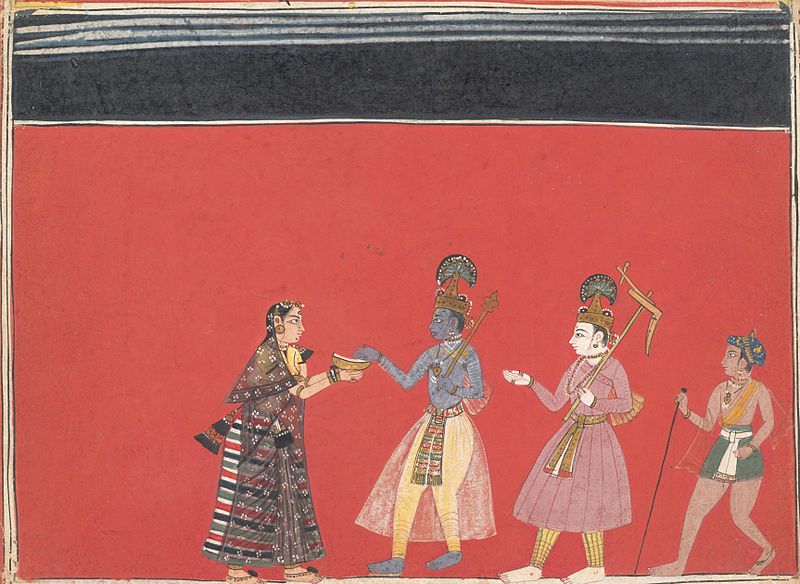File:Krishna Accepts an Offering from the Hunchbacked Woman Trivakra.jpg

Original file (3,452 × 2,522 pixels, file size: 1.76 MB, MIME type: image/jpeg)
Captions
Captions
| DescriptionKrishna Accepts an Offering from the Hunchbacked Woman Trivakra.jpg |
English: While traveling, Krishna encounters the hunchbacked woman Trivakra and notices the wonderful ointments she made for the evil king Kamsa. Overcome by his presence, Trivakra offers the ointments to Krishna, who straightens her crooked back and transforms her into a perfectly proportioned, beautiful woman. The story illustrates Krishna’s miraculous nature and Trivakra’s devotion, which is ultimately manifest as her passionate desire for god. Drawing on earlier painting styles of western India, the Malwa artist reduced the narrative to its essentials, presenting only the brightly lit protagonists against an intense red ground, banded by a darkened skyline. |
| Date |
circa 1650 date QS:P,+1650-00-00T00:00:00Z/9,P1480,Q5727902 |
| Source |
Original publication: ca. 1650 |
| Author | Unknown authorUnknown author |
- Other information
|Public domainPublic domainfalsefalse |}
This work is in the public domain in India because its term of copyright has expired.
The Indian Copyright Act applies in India to works first published in India. According to the Indian Copyright Act, 1957, as amended up to Act No. 27 of 2012 (Chapter V, Section 25):
العربيَّة | বাংলা | Deutsch | English | français | हिन्दी | italiano | 日本語 | ಕನ್ನಡ | македонски | മലയാളം | मराठी | Nederlands | português do Brasil | sicilianu | தமிழ் | ತುಳು | اردو | 繁體中文 | +/− |
 |
| Public domainPublic domainfalsefalse |
This non-U.S. work was published 1929 or later, but is in the public domain in the United States because either
or
This work may still be copyrighted in other countries. For background information, see the explanations on Non-U.S. copyrights. Note: in addition to this statement, there must be a statement on this page explaining why the work is in the public domain in the U.S. (for the first case) or why it was PD on the URAA date in its source country (second case). Additionally, there must be verifiable information about previous publications of the work. |
File history
Click on a date/time to view the file as it appeared at that time.
| Date/Time | Thumbnail | Dimensions | User | Comment | |
|---|---|---|---|---|---|
| current | 11:39, 23 March 2014 |  | 3,452 × 2,522 (1.76 MB) | Gunduu (talk | contribs) | {{subst:Upload marker added by en.wp UW}} {{Information |Description = {{en|While traveling, Krishna encounters the hunchbacked woman Trivakra and notices the wonderful ointments she made for the evil king Kamsa. Overcome by his presence, Trivakra offe... |
You cannot overwrite this file.
File usage on Commons
There are no pages that use this file.
File usage on other wikis
The following other wikis use this file:
Metadata
This file contains additional information such as Exif metadata which may have been added by the digital camera, scanner, or software program used to create or digitize it. If the file has been modified from its original state, some details such as the timestamp may not fully reflect those of the original file. The timestamp is only as accurate as the clock in the camera, and it may be completely wrong.
| Author | Picasa |
|---|---|
| Date and time of data generation | 17:04, 23 March 2014 |
| Software used | Picasa |
| File change date and time | 17:05, 23 March 2014 |
| Exif version | 2.2 |
| Unique image ID | 73f69ee14663113436d454900b77c199 |
| IIM version | 4 |